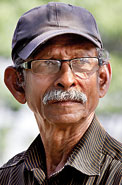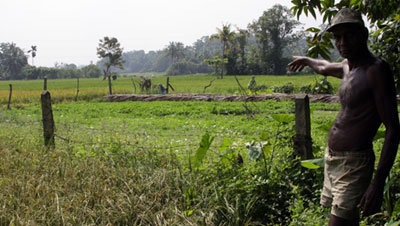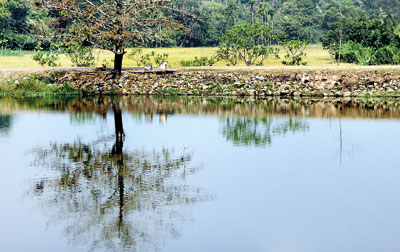He sits on a bench pondering over the fate of his beloved Talangama wewa and its environs. The tranquillity and serenity broken only by bird-calls cannot still the turbulence within him today.
For, the wewa which helps the 175 farmers of the area to irrigate their land, brings them a bountiful crop of paddy from around 200 acres and calms their frazzled lives by its beauty, is under threat.
This is why 68-year-old E. Percy Perera will fight tooth and nail to protect the wewa in the Madiwela catchment area and its surrounding Wetlands. “This may be the only place in the Western Province where children can actually see an ancient pita vana (for the outflow of excess water) cut through a kalu gala (rock),” he says.
Percy and the other farmers are urging the authorities to raise the level of the spill-basin built in the early 1990s which is diverting water to the Kelani River to stem the flooding of Colombo.
The area is not only assailed by this issue – there are also alleged moves by the Sri Lanka Land Reclamation and Development Corporation (SLLRDC) to dig up part of the Wetland and create a man-made lake, bund and all, residents said.
As Percy’s visha vaidya (snake-bite specialist) Seeya K.P.P. Nanayakkara did back in the 1950s, planning the water release to the rice-fields and protecting the ela-wel, Percy has taken upon himself to keep tabs on what is happening at the wewa and guide or fight the authorities whenever the tank or its environs is in jeopardy.
The Talangama wewa originally covering 44 acres is believed to have been built by Parakrama Bahu VI during the Kotte Kingdom. But, smiles Percy taking us down the pathways of history, the tank was not built primarily for irrigation but to bathe the court elephants. The elephants had been taken to a place close to Malabe junction, dubbed athun kedeniya, to be fed and by evening given a dip at the wewa which was the palace thatakaya, before being taken back.
Gradually, with encroachment the tank had shrunk to 20 acres, says Percy.
By 1989-90, when the need arose for more water to be retained in the wewa, the old spill-level was raised by 18”, explains Percy, adding that the tank then reclaimed more than 10 acres of its lost area.
 |
Percy: Fighting
tooth and nail to protect his beloved wewa |
The Colombo Flood Retention Plan to stymie flooding followed, with the SLLRDC putting forward a scheme to construct the spill-basin with a 20” depth. “We feared for the tank,” he recalls, “for up to then even if there had been a drought for six months, the wewa always had water because it’s fed by ulpath (springs).”
Before the spill-basin was constructed, if there were heavy rains and the tank had excess water, it would spill over the bund and the natural cycle took over with the Wetlands absorbing it. We could also open the pita vana, he says.
But the protests were not heeded and even the plea that instead of a permanent spill-basin, there should be sluice gates which could shut the outflow of water was ignored, laments Percy. “They also cut a canal through high ground in the Amaragoda area,” he says, warning that if there are torrential rains the water will come back along the canal to the lake surrounding Parliament and Parliament would get submerged.
The spill-basin with the water flowing out slowly but surely from the tank has given a raw deal to the farmers. Whereas those days they were able to do both the Yala in April and the Maha in October, if the rains don’t come now no water can be given twice or thrice, grumbles Percy, citing how “kumburu sawuththuvuna” during the Yala of 2011.
The diversion has also caused some parts of the tank to dry up with invasive plant species (such as wel atha) spreading rapidly and the Wetland could very well disappear along with the birds. With the destruction of plants, fewer birds like the kithala (induru kukula) are seen, because they lay their delicate eggs on the nelum-leaf, he says, ecstatic on seeing a flock of seru.
 |
| A villager points to the area where the lake is supposed to be dug |
Both groups of migrants, which come a-visiting either the north or the south of the country can usually be seen here, says Percy. Backed by the villagers, Percy’s action plan for his heritage is simple:
Raise the spill-basin to store more water in the wewa and if there is excess water after the rains let it flow from the ancient pita vana and through the village like it has done for centuries; clear the invasive plants; prevent land-grabs from the wel-yaya and the wewa reservations; and crackdown on rubbish-dumping and waste-water being channelled into the wewa.
Will Percy succeed in his battle to save the Talangma wewa, its environs (declared a protected area) and the intricate eco-systems while engaging in paddy cultivations like his forefathers did?
The answer lies with the bureaucrats. When contacted, an Irrigation Department source said the proposals are being studied.
Walk to create awareness
‘Walk for Wetlands’ from Pelawatte to the Talangama Wetlands next Sunday, February 12, at 9 a.m. will be part of measures to create awareness.
Involving the local community including residents, organizations and schools and youth environment groups and environment-conscious organizations, the walk hopes to drive home the message that while enjoying the right to live in a picturesque environment, they also have the responsibility of nurturing and caring for it.
The walk follows an environmental-sociological survey conducted by two past pupils of the Overseas School of Colombo, Olivia Molden (as part of an undergraduate thesis) and Joanne Kotelawala, British Council International Climate Champion and bio-chemistry student.
The main concern highlighted by residents was the increased levels of pollution in the area, while around 50% had indicated that biodiversity loss and filling Wetlands were also recognizable threats. The survey had found that tourism is welcome in the area if it does not clash with the Environmental Protection Zoning.
Who needs a man-made lake?
Confusion and concern surround Kekunugahawatte at Talangama North with residents claiming that some paddy fields and an ela are to be made into a man-made lake while the SLLRDC stressed that only those canals of the existing Averihena wewa would be cleared and dredged.
Whether there is a need to widen the culvert on Amaragoda Road is also being looked into, an SLLRDC spokesperson said.
Why should an artificial lake be created, questioned a resident, pointing out that turning marshy habitat into a lake will not necessarily control flooding. It will only increase the water withholding capacity but not the water-absorbing capacity, which is an important factor in flood control. The destruction of the Wetland would be disastrous.
Another SLLRDC spokesperson explained that the Survey Department was demarcating the boundaries as the government was hoping to Gazette the Wetlands to preserve them, while the UDA was drawing up a zoning plan to identify residential and commercial areas. The development work of the Madiwela East canal diversion would only be with regard to the Averihena wewa and other “retention tanks” in the Colombo upper basin.
This area has been declared “environmentally sensitive” by the Central Environmental Authority, the Sunday Times understands, and diverse fauna inhabit the area including many winged beauties
In just one morning, environmentalist Gehan de Silva Wijeyeratne had spotted 70 bird species and according to him, “Talangama is one of the finest urban wildlife sites in the world comparable to the London Wetland Centre which is rated as Europe's top urban wildlife site”.
A large lake would be relatively barren for wildlife compared to the biodiversity-rich natural Wetland which Talangama is at present, he says.
It is also home to many mammals including the endemic Purple-faced Leaf Monkey, the Fishing Cat and the endemic Yellow-striped Chevrotain (Mouse-deer), he says in an e-mail, adding that there are also over 30 species of dragonflies. |




